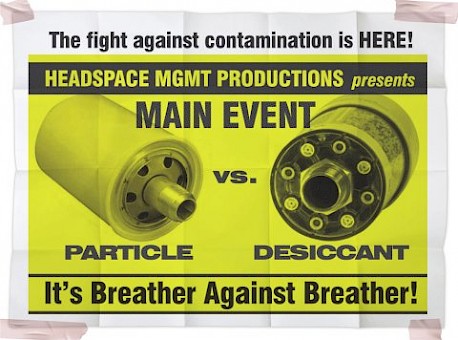Particle Breathers vs. Desiccant Breathers: Which Will Keep Your Oil Contaminant-Free?
 When it comes to managing the headspace of a machine or machine component, many different breathers can be used, such as desiccant breathers, particle breathers, dry instrument air and expansion chambers. In this article, we will discuss the difference between the first two methods mentioned: the particle breather and the desiccant breather. However, before we dive into the differences between these two types of breathers, it is important to understand headspace management and the purpose of breathers.
When it comes to managing the headspace of a machine or machine component, many different breathers can be used, such as desiccant breathers, particle breathers, dry instrument air and expansion chambers. In this article, we will discuss the difference between the first two methods mentioned: the particle breather and the desiccant breather. However, before we dive into the differences between these two types of breathers, it is important to understand headspace management and the purpose of breathers.
The headspace of a lubricated sump is the area between the top of a lubricant and the top of the sump itself. The size of this space can fluctuate as a machine exhales and inhales. There is not much emphasis put on the air that is leaving the machine. However, when a machine breathes in, there is a chance that harmful contaminants such as water and dirt can ingress and potentially cause harm to the lubricant and the machine. For this reason, it’s important that we control what comes in with the air as it enters the machine.
Particle Breathers
Simply put, a particle breather is similar to the filters used to make coffee. Just like a coffee filter is used to keep the coffee grains out of the coffee pot, particle breathers are used to keep particles out of lubricated sumps. One downside of particle breathers is that they can allow water to easily find its way inside our machines, just like the coffee filter. These filters usually come threaded and spun into the top of machines such as gearboxes, hydraulic units and pumps.
Generally, the particle breathers that come on most OEM equipment are not sufficient to properly protect a machine’s headspace. Think of the typical breather that comes on a hydraulic unit - they will usually have a twist-on lid with what looks like steel wool inside. While these will help keep rocks out, they are not able to trap the small particles that cause harm to machine surfaces. You will not often find a micron rating on the side of a particle filter; this rating would show the particle size that the filters are targeting.
| Particle Breathers | Desiccant Breathers | |
|---|---|---|
| 1 oz. - Multiple Pounds | Weight | 1 oz. - Multiple Pounds |
| Generally 3"-12" | Height | 4" to 40" Based on Application |
| Generally Around 40 Micron | Reach | 3 Micron Particles |
Desiccant Breathers
The most important characteristic of a desiccant breather is the ability to desiccate, meaning it can remove moisture. Incoming air is cleaned and dehydrated through an initial solid particle filter, a container of silica gel and then another solid particle filter. Typically, this desiccant material has a limited lifespan - once it becomes saturated or spent, either the desiccant or the entire breather will need to be replaced.
There are many different types of desiccant breathers, ensuring that the headspace will be protected no matter the application. The most basic of these breathers is set up so that both incoming and outgoing air from the machine will go through the desiccant material. If this type of unit is set in a high-moisture area, it will become spent very quickly because it constantly pulls moisture from both the machine and the atmosphere. Very humid environments, like those found in Louisiana and South Texas, can be detrimental to this specific type of breather unless the proper add-ons are implemented.
Other types of desiccant breathers, like those with check valves that only allow air to flow through the desiccant when the machine is inhaling or exhaling, are better suited for humid or wet environments. A few add-ons, depending on the environmental conditions, are wash-down caps, isolation check valves, high-capacity air filters and even manual indicator vacuum gauges.
Summary
Particle breathers will suffice for a short amount of time in perfect conditions, but we’re here to inform you of best practices while assuming the worst conditions. Simply put, particle breathers can’t do half of what desiccant breathers can. In the end, it all comes down to dollars and cents. You can be proactive and protect your equipment by paying to install and utilize desiccants, or you can be reactive and spend thousands of dollars and many man-hours replacing components and lubricants. In comparison to particle breathers, desiccant breathers are the most efficient way of proactively keeping your oil clean and dry, and a proactive step is a step towards lubrication excellence.
